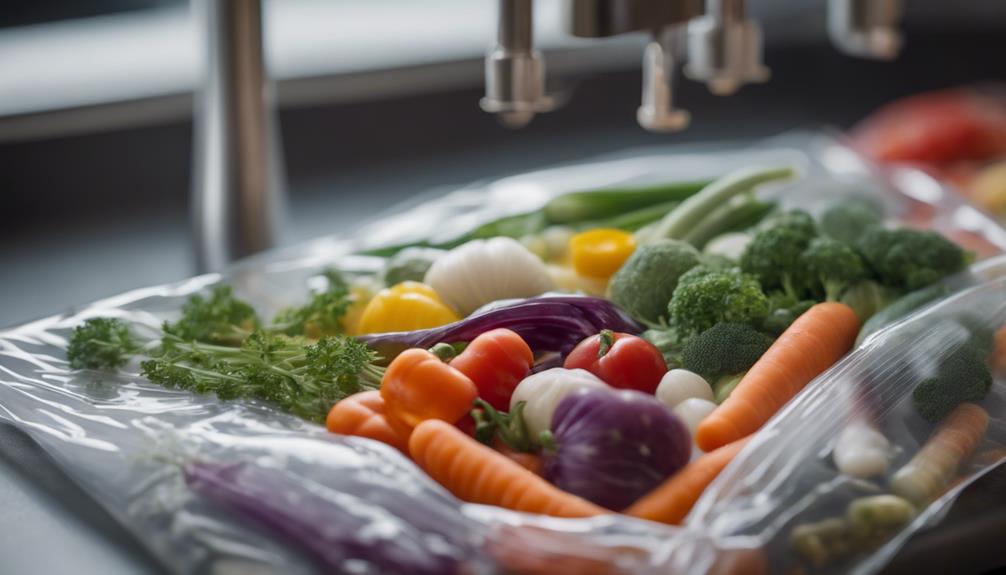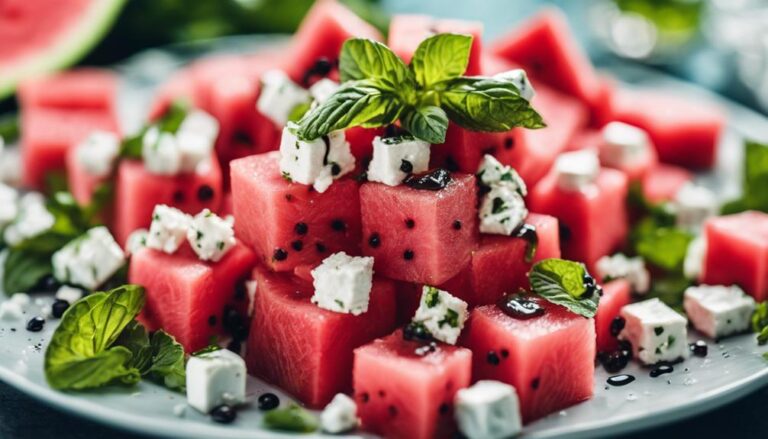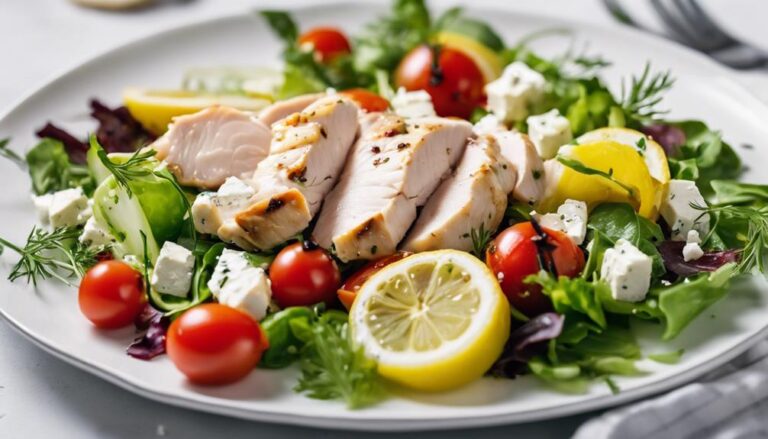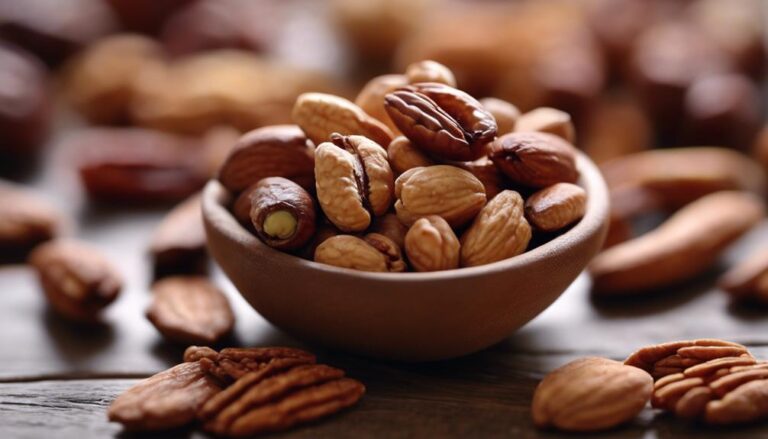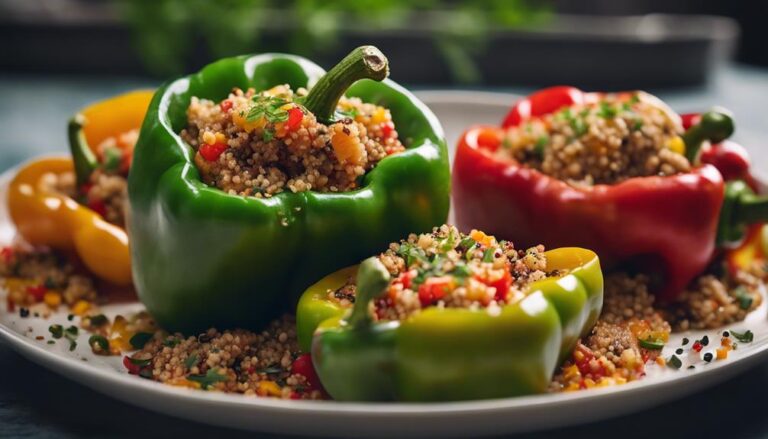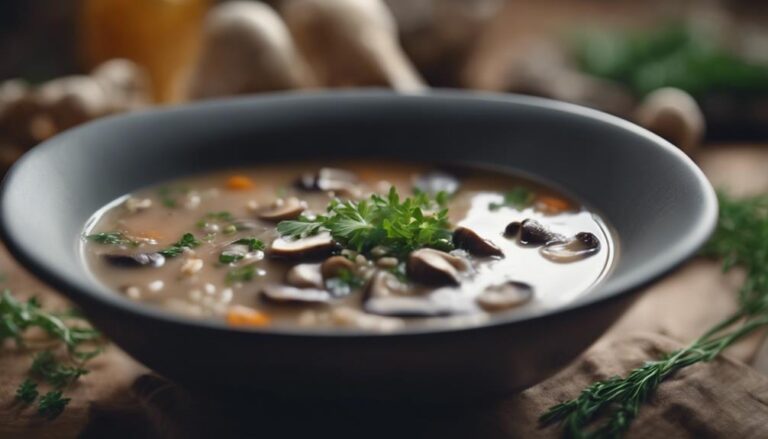Soup Sous Vide Vegetable Minestrone
Ready to take your minestrone soup to the next level? Discover how sous vide cooking can enhance your vegetable minestrone by providing precise temperature control for tender and vibrant veggies. Elevate your soup game with innovative additions like crispy roasted chickpeas, parsnips, and fennel, or experiment with basil or kale pesto swirls. Sous vide techniques guarantee consistent heat distribution, intensifying flavors while locking in essential nutrients. By incorporating seasonal, locally sourced produce, you'll create a delicious and nutritious soup that truly shines. Explore the world of sous vide vegetable minestrone for a culinary experience like no other.
What You Will Learn Here
- Sous vide technique ensures precise temperature control for perfectly cooked vegetables.
- Enhance flavors by locking in nutrients and intensifying natural tastes.
- Use seasonal, fresh vegetables for optimal taste and vibrant colors.
- Experiment with innovative additions like crispy chickpeas or basil pesto swirl.
- Adapt traditional minestrone ingredients to create a unique, flavorful vegetable medley.
Origin of Minestrone Soup

Minestrone soup has a rich history that dates back centuries, showcasing a blend of various culinary traditions.
Traditional minestrone ingredients typically include vegetables, beans, and pasta, creating a hearty and nutritious dish.
Over time, minestrone has evolved to adapt to different regions and tastes, resulting in a wide array of delicious variations.
Minestrone Soup History
The origins of this hearty vegetable soup can be traced back to ancient Roman times when households would prepare a nourishing dish with seasonal ingredients. Minestrone soup holds a significant place in Italian cuisine, renowned for its rich flavors and wholesome ingredients. This beloved soup is a prime example of vegetable-based soups that have been cherished for centuries in Italy.
Throughout different regions in Italy, minestrone has undergone various regional variations, each adding a unique touch to this traditional dish. The cultural significance of minestrone lies in its ability to showcase the freshness and diversity of seasonal vegetables, reflecting the essence of Italian cooking that values simplicity and quality ingredients.
Over time, minestrone has evolved into a versatile and customizable soup, allowing cooks to adapt the recipe based on available produce and personal preferences. Its enduring popularity is a confirmation of the lasting appeal of this classic vegetable soup that continues to be a staple in Italian households and restaurants alike.
Traditional Minestrone Ingredients
Exploring the origins of this beloved vegetable soup reveals a rich tapestry of traditional ingredients that have cemented minestrone's place in Italian culinary history.
Traditional minestrone ingredients typically include a hearty combination of vegetables such as tomatoes, carrots, celery, onions, and zucchini. These vegetables form the base of the soup, providing a robust flavor and a range of textures. Additionally, beans like cannellini beans or kidney beans are commonly used to add protein and substance to the dish.
Popular variations of minestrone may also incorporate ingredients like potatoes, cabbage, spinach, or even pasta, offering a diverse array of flavors and textures. The use of herbs like basil, oregano, and thyme further enhances the aromatic profile of the soup. Olive oil is often used for sautéing the vegetables, contributing to the authentic Italian taste of minestrone.
Understanding these traditional ingredients and their variations is key to appreciating the depth and versatility of minestrone soup in Italian cuisine.
Evolution of Minestrone
Tracing the historical roots of this hearty vegetable soup reveals a fascinating journey through the evolution of Italian culinary traditions. Minestrone, a dish that originated in Italy, has evolved over centuries, adapting to different regions and culinary influences.
The evolution of minestrone reflects the changing availability of ingredients and the creativity of Italian cooks throughout history.
Originally a humble vegetable soup made with seasonal produce, minestrone has transformed into a versatile dish with numerous modern adaptations. While the traditional base of tomatoes, beans, and pasta remains popular, minestrone recipes now incorporate a wide variety of vegetables, grains, and proteins.
The evolution of minestrone has led to regional variations, with each area adding its unique twist to the classic recipe.
Today, minestrone continues to be a beloved dish in Italian cuisine and beyond. Its evolution highlights the adaptability and creativity of chefs who've embraced new ingredients and techniques to create innovative versions of this comforting soup.
Key Minestrone Soup Ingredients
Consider incorporating a variety of fresh vegetables to enhance the flavor and texture of your minestrone soup.
- Vegetable medley: A mix of carrots, celery, zucchini, and tomatoes adds depth and color to your minestrone.
- Flavorful broth: Use a rich vegetable or chicken broth as the base to infuse your soup with savory notes.
- Beans: Cannellini beans or kidney beans not only provide protein but also contribute a creamy texture to your minestrone.
When crafting your minestrone soup, make sure you chop your vegetables evenly to guarantee they cook uniformly. Start by sautéing onions and garlic in olive oil until fragrant, then add the vegetable medley and cook until slightly softened.
Pour in the flavorful broth and let the soup simmer to allow the flavors to meld together. Finally, add in the beans and let them warm through. Season with salt, pepper, and herbs like basil and oregano to elevate the taste profile.
These key ingredients will transform your minestrone into a hearty and satisfying meal.
Top-Rated Minestrone Soup Variations
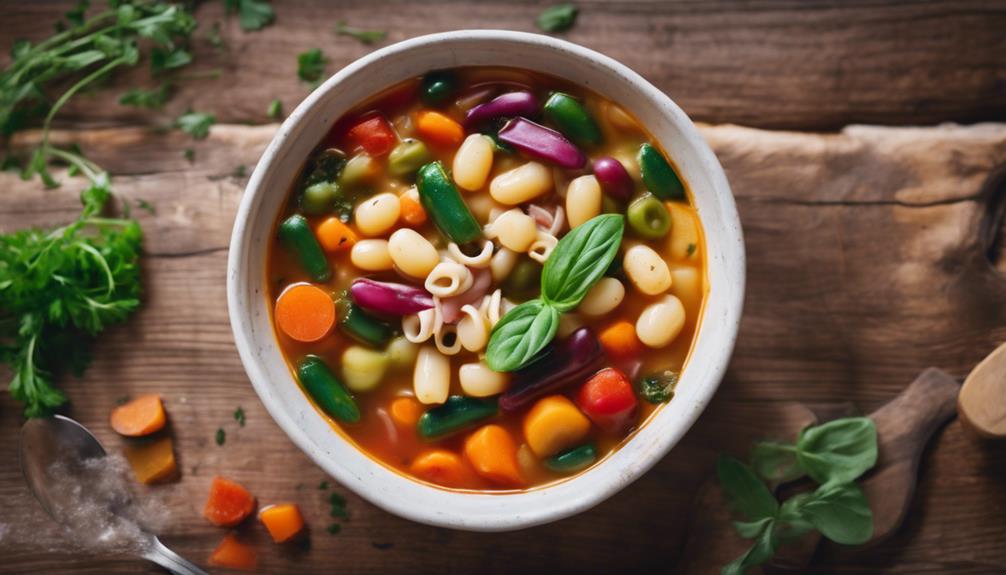
Discover exciting variations of the classic Minestrone soup with these top-rated options: try a Sous Vide Minestrone With Veggies for a modern twist, experiment with a unique Minestrone Soup Version, or savor a Sous Vide Minestrone Twist that will elevate your soup game.
Mixing up the traditional recipe can add a new dimension to your culinary repertoire and surprise your taste buds with innovative flavors. Get ready to expand your soup-making skills with these creative Minestrone interpretations.
Sous Vide Minestrone With Veggies
For a modern twist on traditional minestrone soup, try incorporating sous vide cooking techniques to enhance the flavors of your favorite vegetables. Sous vide techniques allow you to precisely control the cooking temperature, ensuring that each vegetable in your minestrone reaches the perfect level of doneness while preserving its nutrients and natural taste.
Here are three vegetable medley variations worth exploring for your sous vide minestrone:
- Classic Italian Blend: Combine diced tomatoes, zucchini, carrots, celery, and green beans in a vacuum-sealed bag with Italian herbs like oregano and basil for a traditional flavor profile.
- Mediterranean Mix: Opt for a mix of bell peppers, eggplant, artichokes, and fennel seasoned with garlic, thyme, and rosemary to give your minestrone a Mediterranean flair.
- Asian Fusion: Experiment with bok choy, shiitake mushrooms, snow peas, and bamboo shoots infused with soy sauce, ginger, and a touch of sesame oil to create an Asian-inspired twist on this classic soup.
Sous Vide Minestrone Twist
Enhancing the traditional minestrone soup with sous vide cooking techniques can elevate the flavors of your favorite vegetables to a whole new level of culinary excellence. When exploring the Sous Vide Minestrone Twist, consider the following:
- Sous Vide Benefits: Sous vide cooking involves sealing ingredients in a vacuum-sealed bag and cooking them in a water bath at precise temperatures. This method guarantees that the vegetables retain their nutrients and flavors, resulting in a more vibrant and intense taste in your minestrone soup.
- Vegetable Variations: With sous vide, you can experiment with a wide range of vegetables in your minestrone, from classic choices like carrots and celery to more exotic options like kale and leeks. The controlled cooking environment allows each vegetable to maintain its unique texture and taste, adding depth to your dish.
- Innovative Cooking Techniques: Sous vide introduces innovative cooking techniques to traditional minestrone preparation. By infusing flavors slowly and evenly, this method enhances the overall taste profile of the soup, making each spoonful a burst of rich, concentrated flavors while ensuring top-notch flavor retention in every ingredient.
Unique Minestrone Soup Version
Exploring a unique twist on traditional minestrone soup variations can introduce exciting flavors and textures to your culinary repertoire.
When looking to create a standout minestrone soup, consider these three innovative additions to elevate your dish:
- Flavorful Textures: Incorporate crispy roasted chickpeas as a garnish for a delightful crunch in every bite. The contrast between the creamy broth and the crunchy chickpeas adds a new dimension to the soup's texture profile.
- Vegetable Medley: Instead of the usual vegetables like carrots and celery, try adding parsnips and fennel to your minestrone. These unique vegetables bring a slightly sweet and aromatic flavor that pairs beautifully with the savory broth.
- Herbaceous Pesto Swirl: Finish off your minestrone with a swirl of basil or kale pesto. The fresh herbaceous notes from the pesto not only enhance the overall taste but also add a vibrant pop of color to your dish.
Sous Vide Temperature Control
When using sous vide for your vegetable minestrone, it's important to pay attention to the precise temperature settings.
This method guarantees consistent heat distribution throughout the cooking process, allowing for even cooking.
Precise Temperature Settings
To achieve perfect results with sous vide cooking, make sure you set the precise temperature settings for your vegetable minestrone. Sous vide cooking offers the benefits of temperature precision, allowing you to control the exact heat your ingredients are exposed to.
When preparing vegetable minestrone using sous vide techniques, you can modify traditional recipes to enhance flavors and textures.
By setting the temperature precisely, you can guarantee that your vegetables are cooked to perfection, retaining their nutrients and flavors. Different vegetables may require varying temperatures, so it's crucial to adjust accordingly for each ingredient in your minestrone.
The sous vide method allows for gentle cooking at a consistent temperature, resulting in tender vegetables that maintain their vibrant colors and fresh taste.
Whether you're adding root vegetables, leafy greens, or beans to your minestrone, precise temperature settings will help you achieve a delicious and wholesome dish.
Experiment with different temperatures to find the perfect balance for your vegetable minestrone, creating a flavorful and nutritious meal using sous vide cooking.
Consistent Heat Distribution
Achieve uniform cooking results by guaranteeing consistent heat distribution when using sous vide temperature control for your vegetable minestrone. Consistent cooking is key to achieving even doneness throughout your minestrone ingredients. Sous vide cooking maintains a constant temperature, allowing your vegetables to cook evenly without any hot spots that can lead to overcooking or undercooking certain parts of your dish.
To guarantee consistent heat distribution, make sure to arrange your vegetables in a single layer within the vacuum-sealed bags. This allows the water to circulate freely around each piece, ensuring that every vegetable receives the same amount of heat.
Additionally, using a reliable sous vide machine with accurate temperature control is essential for achieving consistent results.
Enhanced Flavor Infusion
For the best flavor infusion using sous vide temperature control, make sure to marinate your vegetables with herbs and spices before vacuum sealing them for cooking. This pre-sous vide marination process allows the flavors to penetrate the vegetables, enhancing the overall taste of your minestrone soup.
Sous vide is a precise cooking technique that involves cooking food in vacuum-sealed bags at a controlled temperature in a water bath. By marinating your vegetables before sous vide cooking, you guarantee that the herbs and spices infuse into the vegetables, creating a depth of flavor that traditional cooking methods may not achieve.
The sous vide temperature control maintains a consistent heat distribution throughout the cooking process, resulting in evenly cooked vegetables with enhanced flavor infusion. This method allows the vegetables to cook gently and retain their natural juices and nutrients, leading to a more vibrant and flavorful minestrone soup.
Experiment with different herb and spice combinations during the marination process to tailor the flavor profile of your soup to your liking. By utilizing sous vide temperature control for enhanced flavor infusion, you can elevate the taste of your vegetable minestrone to new heights.
Final Thoughts

In wrapping up the discussion on this delectable Sous Vide Vegetable Minestrone, consider incorporating a variety of seasonal vegetables for added freshness and flavor. By utilizing sous vide cooking techniques, you can lock in nutrients and intensify the natural taste of each ingredient. This method allows for precise control over the cooking temperature, resulting in perfectly cooked vegetables with enhanced textures.
When selecting your vegetables, think about the flavor profiles you want to highlight in your minestrone. For a sweeter taste, carrots and sweet potatoes work well, while zucchini and tomatoes can add a invigorating tanginess. Don't shy away from experimenting with different combinations to find what suits your palate best.
Remember that the key to a fantastic minestrone lies in the quality of your ingredients. Opt for fresh, locally sourced produce whenever possible to elevate the overall taste of your dish. With a little creativity and attention to detail, you can create a vegetable minestrone that isn't only nutritious but bursting with delicious flavors.
Enjoy the process of crafting this wholesome and satisfying soup in your own kitchen.
Frequently Asked Questions
Can I Freeze Leftover Sous Vide Vegetable Minestrone?
Sure, you can freeze leftover soup for later. To maintain freshness, use airtight containers or freezer bags. When reheating, add a splash of broth to restore consistency. Experiment with flavor variations like adding fresh herbs or a squeeze of lemon.
How Can I Adjust the Cooking Time for a Larger Batch?
To adjust cooking time for a larger batch, scale the recipe properly. Increase cooking time slightly, keeping an eye on doneness. Remember, batch cooking may alter timing, so adjust as needed for best results.
What Are Some Creative Garnish Ideas for Presentation?
To elevate your dish, consider garnishing with edible flowers, herb-infused oils, colorful veggie spirals, and Parmesan crisps. These additions not only enhance presentation but also add a burst of flavor to your creation.
Can I Use Different Vegetables in the Sous Vide Minestrone?
Yes, you can absolutely use different vegetables in your sous vide minestrone. Experiment with vegetable substitutions to create unique flavor variations. Try various cooking techniques and ingredient combinations to elevate the taste of your dish.
Does the Sous Vide Method Affect the Texture of the Vegetables in the Soup?
When you sous vide vegetables, the cooking temperature gently cooks them, maintaining their tenderness. The longer cooking duration can impact taste by intensifying flavors. Overall, sous vide method preserves the texture and enhances the taste of vegetables.
Conclusion
To sum up, utilizing the sous vide method to prepare a vegetable minestrone soup offers precise temperature control and enhances the flavors of the ingredients.
This modern cooking technique allows for a delicious and nutritious soup that can be easily customized to suit individual preferences.
Whether you prefer a classic minestrone recipe or want to experiment with new variations, sous vide cooking is a great way to elevate your soup-making skills.
Give it a try and enjoy a flavorful and satisfying meal!
